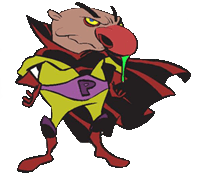Kid-friendly Fact Sheet
The Pertussis Disease Villain
Español: Hoja informativa para niños
Meet pertussis, a disease villain from BAM! Body and Mind, that leaves its victims literally gasping for air.
Print-friendly version (586 KB, 1 page)

Real name: Pertussis
Also Known as (AKA): Whoopie Doopies
Known aliases: Bordetella pertussis (the bacteria that causes pertussis illness); whooping cough (for the "whoop" sound of someone gasping for air after a coughing spell)
Microbe type: bacterium
Profile
Pertussis leaves its victims literally gasping for air. At first, this tricky pretender might seem like a common cold—runny nose, fever, and cough. That's stage 1, when pertussis is just warming up. After a week or two, pertussis infection delivers its cruel surprise—extreme coughing spells. In these fits people can literally cough so hard and long that they throw up or turn blue because they can't breathe. Victims of pertussis make a gasping "whoop" sound when they suck in air after a coughing fit. Pertussis infection is no joke—about 40% of infants who get it wind up in the hospital! Weeks after Stage 2, as the body finally fends off pertussis, the victims' cough tapers down.
Powers & Abilities
Pertussis is highly contagious (easy to catch). Want proof? A person with pertussis will infect almost everyone in their household if those people are not protected by vaccination.
Preferred Method of Attack
Pertussis is primarily an "air attacker," flying through the air looking for its next victim, when an infected person coughs or sneezes. The bacterium may also infect people who touch places where wetness from those coughs and sneezes lands, and then touch their noses our mouths.
Known Weaknesses
Pertussis fears four letters -- D, T, a and P -- and 2 vaccines, "DTaP" and "Tdap". Kids get "DTaP" while teenagers and grownups get a "boost" with "Tdap." The vaccine ammo contains diphtheria (the D), tetanus (the T), and acellular pertussis (aP). The term "acellular" (pronounced A-SELL-you-lur) means that the vaccine uses pieces of pertussis bacteria (not the whole bacterium cell). By using just pieces, the vaccine can "teach" the body to protect itself, with the fewest side effects.
Since the days before the vaccine, pertussis cases are down more than 80%.
Pertussis may be tough, but some simple basics can help to keep it in check: like washing hands with soap, covering up coughs and sneezes, and not sharing cups and silverware.
Preferred Victims
Pertussis is a bully, slamming young children and babies the hardest. Also, other bacterial infectors just love to join pertussis' party, moving into a sick person's pertussis-infected lungs and throat to cause their own infections. These are called "secondary infections." Pertussis mostly pulls off its complications among young children, too—such as pneumonia, seizures, and encephalopathy (disease of the brain).
Precautions for the Public
Stay vigilant. We may think we've gotten the upper hand against pertussis. But, the disease is always scheming to get back on top. Since the 1980s, doctors have been reporting increasing numbers of pertussis cases. At the moment, there are still far fewer cases than there were before the vaccine. Still, the number of people infected seems to peak every three or four years, showing that pertussis is still out there figuring out its next move.
Area of Operations
Pertussis operates worldwide. It is especially busy and deadly in developing areas of the world, where fewer people are vaccinated and medical care is less accessible. Pertussis infects millions of people each year, and claims hundreds of thousands of lives.
Criminal Record
Doctors have been dealing with pertussis for at least 500 years. Finally, in 1906, scientists were able to identify and see Bordetella pertussis bacteria through a microscope—a first step in learning how to stop its evil tricks. From 1940–45, before the vaccine was widely used, 175,000 people in the U.S. were infected each year. In the 1940s, vaccinating against pertussis became routine and the tables turned for the better. Now, 1,000 to 27,000 people are infected each year, and very few die.
Images and logos on this website which are trademarked/copyrighted or used with permission of the trademark/copyright or logo holder are not in the public domain. These images and logos have been licensed for or used with permission in the materials provided on this website. The materials in the form presented on this website may be used without seeking further permission. Any other use of trademarked/copyrighted images or logos requires permission from the trademark/copyright holder...more
![]() This graphic notice means that you are leaving an HHS Web site. For more information, please see the Exit Notification and Disclaimer policy.
This graphic notice means that you are leaving an HHS Web site. For more information, please see the Exit Notification and Disclaimer policy.
Contact Us:
- Centers for Disease Control and Prevention
1600 Clifton Rd
Atlanta, GA 30333 - 800-CDC-INFO
(800-232-4636)
TTY: (888) 232-6348 - New Hours of Operation
8am-8pm ET/Monday-Friday
Closed Holidays - cdcinfo@cdc.gov


